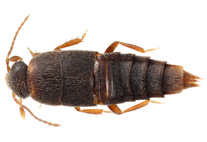Abstract
Early development of fat snook, Centropomus parallelus (Poey 1860), is described based on embryos and larvae obtained from rearing experiments and from specimens caught in the field, in Cananéia, southeastern Brazil, during December 1999–January 2000. Larvae of common snook, C. undecimalis, were also collected to compare the pigmentation pattern and body shape. Eggs of C. parallelus were relatively small (0.65 to 0.70 mm in diameter), spherical, and usually with a single oil globule. Notochord length (NL) of newly hatched ranged between 1.1 mm to 1.4 mm. Notochord flexion began at 3.4 mm NL and was usually completed by 4.0 mm SL. Larval and early juvenile of both species were very similar with tenuous distinction, however, some morphological and pigmentation characters were used to distinguish their early stages. The main differences were as follow: trend of lower values of the ratio of body depth to body length (BD/BL) for C. par-allelus larger than 10.0 mm SL; absence of the post-temporal spine in C. undecimalis; absence of pigmentation along the dorsal midline of C. parallelus larvae by 2.6–7.0 mm; and presence of a pair of dendritic melanophores posterior to the bases of pelvic fins in C. parallelus larger than 6.0.

